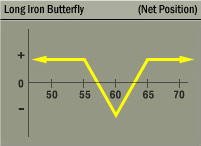Strategy Highlights
-
MotivationProfit from a move in the underlying stock in either direction.
-
Sharp Move Up or DownThe investor is looking for a sharp move either up or down in the underlying stock during the life of the options.
-
Maximum GainThe maximum gain would occur should the underlying stock be outside the wings at expiration.
-
Maximum LossThe maximum loss would occur should the underlying stock be at the body of the butterfly at expiration.
-
Time DecayAs with most strategies where the investor is a net buyer of option premium, passage of time, all other things equal, will have a negative effect on this strategy.
-
Volatility ImpactAn increase in implied volatility, all other things equal, would have a positive impact on this strategy.
Long Iron Butterfly
This strategy profits if the underlying stock is outside the wings of the iron butterfly at expiration.
Description
This strategy combines a short call at an upper strike, a long call and long put at a middle strike, and short a put at lower strike. The upper and lower strikes (wings) must both be equidistant from the middle strike (body), and all the options must be the same expiration.
An alternative way to think about this strategy is a long straddle with a short strangle. It could also be considered as a bull call spread and a bear put spread.
Outlook
The investor is looking for a sharp move either up or down in the underlying stock during the life of the options.
Summary
This strategy profits if the underlying stock is outside the wings of the iron butterfly at expiration.
Motivation
Profit from a move in the underlying stock in either direction.

Example
- Short 1 XYZ 65 call
- Long 1 XYZ 60 call
- Long 1 XYZ 60 put
- Short 1 XYZ 55 put
MAXIMUM GAIN
- High strike - middle strike - net premium paid
MAXIMUM LOSS
- Net premium paid
Variations
While this strategy has a similar risk/reward profile to the short call butterfly and short put butterfly, the long iron butterfly differs in that a negative cash flow occurs up front, and any positive cash flow is uncertain and would occur somewhere in the future.
Max Loss
The maximum loss would occur should the underlying stock be at the body of the butterfly at expiration. In that case all the options would expire worthless, and the premium paid to initiate the position would have been lost.
Max Gain
The maximum gain would occur should the underlying stock be outside the wings at expiration. In that case, either both calls or both puts would be in-the-money. The profit would be the difference between the body and either wing, less the premium paid to initiate the position.
Profit/Loss
The potential profit and loss are both very limited. In essence, an iron butterfly at expiration has a minimum value of zero and a maximum value equal to the distance between either wing and the body. An investor who buys an iron butterfly pays a premium somewhere between the minimum and maximum value, and profits if the butterfly's value moves toward the maximum as expiration approaches.
Breakeven
The strategy breaks even if at expiration the underlying stock is either above or below the body of the butterfly by the amount of premium paid to initiate the position.
Volatility
An increase in implied volatility, all other things equal, would have a positive impact on this strategy.
Time Decay
As with most strategies where the investor is a net buyer of option premium, passage of time, all other things equal, will have a negative effect on this strategy.
Assignment Risk
Yes. The short options that form the wings of the butterfly are subject to exercise at any time, while the investor decides if and when to exercise the body. If an early exercise occurs at the wing, the investor can exercise an option at the body (put or call, whichever is appropriate) to lock in the maximum gain and continue to hold the other half of the position, which might still have value. So early exercise might be a good thing, although it may require borrowing stock or financing stock for one business day.
And be aware, a situation where a stock is involved in a restructuring or capitalization event, such as a merger, takeover, spin-off or special dividend, could completely upset typical expectations regarding early exercise of options on the stock.
Expiration Risk
Yes. This strategy has expiration risk. If at expiration the stock is trading right at either wing the investor faces uncertainty as to whether or not they will be assigned on that wing. Should the investor not be assigned on the wing, they could be unexpectedly long or short the stock on the Monday following expiration and hence subject to an adverse move over the weekend.
Comments
N/A
Related Position
Comparable Position: Short Call Butterfly
Opposite Position: Short Iron Butterfly

